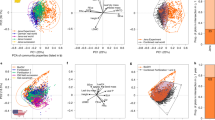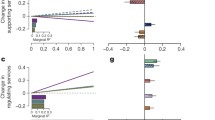Abstract
Increasing concern about loss of biodiversity and its effects on ecosystem functioning has triggered a series of manipulative experiments worldwide, which have demonstrated a general trend for ecosystem functioning to increase with diversity. General mechanisms proposed to explain diversity effects include complementary resource use and invoke a key role for species’ functional traits. The actual mechanisms by which complementary resource use occurs remain, however, poorly understood, as well as whether they apply to tree-dominated ecosystems. Here we present an experimental approach offering multiple innovative aspects to the field of biodiversity–ecosystem functioning (BEF) research. The International Diversity Experiment Network with Trees (IDENT) allows research to be conducted at several hierarchical levels within individuals, neighborhoods, and communities. The network investigates questions related to intraspecific trait variation, complementarity, and environmental stress. The goal of IDENT is to identify some of the mechanisms through which individuals and species interact to promote coexistence and the complementary use of resources. IDENT includes several implemented and planned sites in North America and Europe, and uses a replicated design of high-density tree plots of fixed species-richness levels varying in functional diversity (FD). The design reduces the space and time needed for trees to interact allowing a thorough set of mixtures varying over different diversity gradients (specific, functional, phylogenetic) and environmental conditions (e.g., water stress) to be tested in the field. The intention of this paper is to share the experience in designing FD-focused BEF experiments with trees, to favor collaborations and expand the network to different conditions.


Similar content being viewed by others
References
Allan E, Weisser W, Weigelt A, Roscher C, Fischer M, Hillebrand H (2011) More diverse plant communities have higher functioning over time due to turnover in complementary dominant species. Proc Natl Acad Sci 108:17034–17039
Ashton IW, Miller AE, Bowman WD, Suding KN (2010) Niche complementarity due to plasticity in resource use: plant partitioning of chemical N forms. Ecology 91:3252–3260
Boivin F, Paquette A, Papaik MJ, Thiffault N, Messier C (2010) Do position and species identity of neighbours matter in 8–15 year old post harvest stands in the boreal mixedwood? For Ecol Manage 260:1124–1131
Boyden SB, Reich PB, Puettmann KJ, Baker TR (2009) Effects of density and ontogeny on size and growth ranks of three competing tree species. J Ecol 97:277–288
Brooker RW et al (2008) Facilitation in plant communities: the past, the present and the future. J Ecol 96:18–34
Cadotte MW, Cavender-Bares J, Tilman D, Oakley TH (2009) Using phylogenetic, functional and trait diversity to understand patterns of plant community productivity. PLoS ONE 4:e5695
Caliman A, Pires AF, Esteves FA, Bozelli RL, Farjalla VF (2010) The prominence of and biases in biodiversity and ecosystem functioning research. Biodivers Conserv 19:651–664
Callaway RM, Pennings SC, Richards CL (2003) Phenotypic plasticiy and interactions among plants. Ecology 84:1115–1128
Cardinale BJ et al (2011) The functional role of producer diversity in ecosystems. Am J Bot 93:572–592
Cavender-Bares J, Ackerly DD, Kozak KH (2012) Integrating ecology and phylogenetics: the footprint of history in modern-day communities. 1. Ecology 93:S1–S3
Clarke KR, Warwick RM (2001) A further biodiversity index applicable to species lists: variation in taxonomic distinctness. Mar Ecol Prog Ser 216:265–278
Claus A, George E (2005) Effect of stand age on fine-root biomass and biomass distribution in three European forest chronosequences. Can J For Res 35:1617–1625
Devictor V, Mouillot D, Meynard C, Jiguet F, Thuiller W, Mouquet N (2010) Spatial mismatch and congruence between taxonomic, phylogenetic and functional diversity: the need for integrative conservation strategies in a changing world. Ecol Lett 13:1030–1040
Diaz S, Lavorel S, de Bello F, Quetier F, Grigulis K, Robson TM (2007) Incorporating plant functional diversity effects in ecosystem service assessments. Proc Natl Acad Sci 104:20684–20689
Díaz S et al (2004) The plant traits that drive ecosystems: evidence from three continents. J Veg Sci 15:295–304
Duffy JE (2009) Why biodiversity is important to the functioning of real-world ecosystems. Front Ecol Environ 7:437–444
Faith DP (1992) Conservation evaluation and phylogenetic diversity. Biol Conserv 61:1–10
Fraser LH et al (2012) Coordinated distributed experiments: an emerging tool for testing global hypotheses in ecology and environmental science. Front Ecol Environ 11:147–155
Gravel D, Bell T, Barbera C, Combe M, Pommier T, Mouquet N (2012) Phylogenetic constraints on ecosystem functioning. Nature Commun 3
Hector A et al (1999) Plant diversity and productivity experiments in European grasslands. Science 286:1123–1127
Helmus MR, Bland TJ, Williams CK, Ives AR (2007) Phylogenetic measures of biodiversity. Am Nat 169:E68–E83
Holt R (1977) Predation, apparent competition, and the structure of prey communities. Theor Popul Biol 12:197–229
Hooper DU et al (2012) A global synthesis reveals biodiversity loss as a major driver of ecosystem change. Nature advance online publication
Hooper DU et al (2005) Effects of biodiversity on ecosystem functioning: a consensus of current knowledge. Ecol Monogr 75:3–35
Jiang L, Wan S, Li L (2009) Species diversity and productivity: why do results of diversity-manipulation experiments differ from natural patterns? J Ecol 97:603–608
Kennedy TA, Naeem S, Howe KM, Knops JMH, Tilman D, Reich PB (2002) Biodiversity as a barrier to ecological invasion. Nature 417:636–638
Laliberté E, Legendre P (2010) A distance-based framework for measuring functional diversity from multiple traits. Ecology 91:299–305
Lei X, Wang W, Peng C (2009) Relationships between stand growth and structural diversity in spruce-dominated forests in New Brunswick, Canada. Can J For Res 39:1835–1847
Lei P, Scherer-Lorenzen M, Bauhus J (2012) The effect of tree species diversity on fine-root production in a young temperate forest. Oecologia 169:1105-1115
Li JT, Duan HN, Li SP, Kuang JL, Zeng Y, Shu WS (2010) Cadmium pollution triggers a positive biodiversity-productivity relationship: evidence from a laboratory microcosm experiment. J Appl Ecol 47:890–898
Lieffers VJ, Pinno BD, Stadt KJ (2002) Light dynamics and free-to-grow standards in aspen-dominated mixedwood forests. For Chron 78:137–145
Loreau M (1998) Biodiversity and ecosystem functioning: a mechanistic model. Proc Natl Acad Sci USA 95:5632–5636
Loreau M, Hector A (2001) Partitioning selection and complementarity in biodiversity experiments. Nature 412:72–76
Loreau M (2004) Does functional redundancy exist? Oikos 104:606-611
Maron JL, Marler M, Klironomos JN, Cleveland CC (2011) Soil fungal pathogens and the relationship between plant diversity and productivity. Ecol Lett 14:36–41
Marquard E et al (2009) Plant species richness and functional composition drive overyielding in a six-year grassland experiment. Ecology 90:3290–3302
Martin CW, Hornbeck JW, Likens GE, Buso DC (2000) Impacts of intensive harvesting on hydrology and nutrient dynamics of northern hardwood forests. Can J Fish Aquat Sci 57:19–29
McGill BJ, Enquist BJ, Weiher E, Westoby M (2006) Rebuilding community ecology from functional traits. Trends Ecol Evol 21:178–185
Messier C, Kimmins JP (1991) Above- and below-ground vegetation recovery in recently clearcut and burned sites dominated by Gaultheria shallon in coastal British Columbia. For Ecol Manage 46:275–294
Montès N et al (2008) On the relative importance of the effects of selection and complementarity as drivers of diversity-productivity relationships in Mediterranean shrublands. Oikos 117:1345–1350
Nadrowski K, Wirth C, Scherer-Lorenzen M (2010) Is forest diversity driving ecosystem function and service? Current Opinion Environ Sustain 2:75–79
Naeem S (2002) Disentangling the impacts of diversity on ecosystem functioning in combinatorial experiments. Ecology 83:2925–2935
Paquette A, Messier C (2011) The effect of biodiversity on tree productivity: from temperate to boreal forests. Glob Ecol Biogeogr 20:170–180
Petchey OL, Gaston KJ (2006) Functional diversity: back to basics and looking forward. Ecol Lett 9:741–758
Poisot T, Mouquet N, Gravel D (2013) Trophic complementarity drives the biodiversity-ecosystem functioning relationship in food webs. Ecol Lett (in press)
Reich PB et al (2001) Plant diversity enhances ecosystem responses to elevated CO2 and nitrogen deposition. Nature 410:809–810
Reich PB et al (2004) Species and functional group diversity independently influence biomass accumulation and its response to CO2 and N. Proc Natl Acad Sci 101:10101–10106
Reich PB et al (2012) Impacts of biodiversity loss escalate through time as redundancy fades. Science 336:589–592
Reiss J, Bridle JR, Montoya JM, Woodward G (2009) Emerging horizons in biodiversity and ecosystem functioning research. Trends Ecol Evol 24:505–514
Roscher C et al (2012) Using plant functional traits to explain diversity–productivity relationships. PLoS ONE 7:e36760
Royal Botanic Gardens Kew (2008) Seed Information Database (SID), version 7.1
Ruiz-Benito P, Gómez-Aparicio L, Paquette A, Messier C, Kattge J, Zavala MA (2013) Diversity increases carbon storage and tree productivity in Spanish forests. Global Ecol Biogeogr (in press)
Sánchez-Humanes B, Espelta JM (2011) Increased drought reduces acorn production in Quercus ilex coppices: thinning mitigates this effect but only in the short term. Forestry 84:73–82
Sapijanskas J, Potvin C, Loreau M (2012) Beyond shading: litter production by neighbours contributes to overyielding in tropical trees. Ecology
Scherber C et al (2006) Effects of plant diversity on invertebrate herbivory in experimental grassland. Oecologia 147:489–500
Scherer-Lorenzen M, Schulze ED, Don A, Schumacher J, Weller E (2007) Exploring the functional significance of forest diversity: a new long-term experiment with temperate tree species (BIOTREE). Perspect Plant Ecol Evol Syst 9:53–70
Schnitzer SA et al (2011) Soil microbes drive the classic plant diversity-productivity pattern. Ecology 92:296–303
Spehn EM et al (2005) Ecosystem effects of biodiversity manipulations in european grasslands. Ecol Monogr 75:37–63
Srivastava DS, Cadotte MW, MacDonald AAM, Marushia RG, Mirotchnick N (2012) Phylogenetic diversity and the functioning of ecosystems. Ecol Lett 15:637–648
Steudel B et al (2012) Biodiversity effects on ecosystem functioning change along environmental stress gradients. Ecol Lett 16:568–567
Symstad AJ et al (2003) Long-term and large-scale perspectives on the relationship between biodiversity and ecosystem functioning. Bioscience 53:89–98
Thompson K, Askew AP, Grime JP, Dunnett NP, Willis AJ (2005) Biodiversity, ecosystem function and plant traits in mature and immature plant communities. Funct Ecol 19:355–358
Vandermeer JH (1989) The ecology of intercropping. Cambridge University Press, Cambridge
Vilà M, Vayreda J, Gracia C, Ibáñez JJ (2003) Does tree diversity increase wood production in pine forests? Oecologia 135:299–303
Vilà M, Vayreda J, Comas L, Ibáñez JJ, Mata T, Obón B (2007) Species richness and wood production: a positive association in Mediterranean forests. Ecol Lett 10:241–250
Vilà M et al (2013) Disentangling biodiversity and climatic determinants of wood production. PLoS ONE 8:e53530
Violle C et al (2007) Let the concept of trait be functional! Oikos 116:882
Wacker L, Baudois O, Eichenberger-Glinz S, Schmid B (2009) Diversity effects in early-and mid-successional species pools along a nitrogen gradient. Ecology 90:637–648
Warren J, Topping C, James P (2009) A unifying evolutionary theory for the biomass–diversity–fertility relationship. Theor Ecol 2:119–126
Wright IJ et al (2004) The worldwide leaf economics spectrum. Nature 428:821–827
Zanne AE et al (2009) Data from: towards a worldwide wood economics spectrum. Dryad Digital Repository. Dryad
Zeugin F, Potvin C, Jansa J, Scherer-Lorenzen M (2010) Is tree diversity an important driver for phosphorus and nitrogen acquisition of a young tropical plantation? For Ecol Manage 260:1424–1433
Zhang Y, Chen HYH, Reich PB (2012) Forest productivity increases with evenness, species richness and trait variation: a global meta-analysis. J Ecol 100:742–749
Acknowledgments
A large number of researchers are already conducting experiments on existing IDENT sites, or are in the process of establishing new ones. The authors wish to thank them for stimulating exchanges of ideas. A. Stefanski’s help with setting up the AuCl experiment is much appreciated, as well as the everlasting support of the Quebec provincial nurseries. Also, we wish to express our deepest gratitude to the numerous people that have helped establish and maintain the present sites. IDENT is part of the TreeDivNet, an international platform for research on the relation between tree species diversity and ecosystem functioning, which helped foster yet more exchange of ideas and new partnerships at the last meeting in Florence, Italy (February 2013). Two anonymous reviewers contributed constructive ideas to help improve this article. This work complies with the current laws of Canada and the USA, in which the experiments were established.
Author information
Authors and Affiliations
Corresponding author
Additional information
Communicated by Bernhard Schmid.
C. M. Tobner and A. Paquette contributed equally to this work.
Rights and permissions
About this article
Cite this article
Tobner, C.M., Paquette, A., Reich, P.B. et al. Advancing biodiversity–ecosystem functioning science using high-density tree-based experiments over functional diversity gradients. Oecologia 174, 609–621 (2014). https://doi.org/10.1007/s00442-013-2815-4
Received:
Accepted:
Published:
Issue Date:
DOI: https://doi.org/10.1007/s00442-013-2815-4




